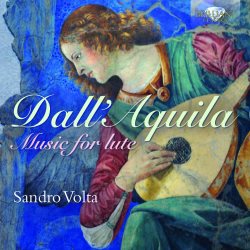| 
|
Marco DALL’AQUILA (c.1480-1538)
Music for Lute
For track-listing see below
Sandro Volta (six-course lute by Ivo Magherini)
rec. April 2013, Santa Croce Museum, Umbertide, Perugia, Italy
BRILLIANT CLASSICS 94805 [49.09]
Marco Dall’Aquila is a very shadowy figure and it's not surprising if you have not heard of him or any of his output. Well done to Sandro Volta and Brilliant Classics for giving us a chance to listen to his voice. It's just a shame that the CD gives us less than fifty minutes of music. All this despite its rarity and the fact that the new critical edition by Arthur J. Ness of Dall’Aquila’s complete works will amount to four volumes. The composer’s biography - as far as we know it - adds up to his probably having spent much of his life in Venice working for aristocratic families. His style is in transition between the early and late renaissance.
The short Ricercar No. 6 shows off one of his compositional methods. It begins homophonically with a dance rhythm of long and two shorts. From this it gradually builds the counterpoint in upper and lower voices adding ornaments and imitation. There is a modulation at the midway point before a general repetition with few alterations: a simple example.
The Ricercar No. 7 is in a minor mode and is one of the longest. This is not just a result of a slower tempo but with the longer phrase lengths and added ornamentation contributing to the melancholic mood. The second section moves becomes more impassioned and changes the mode. The third section - which could almost be a - Pavan returns to its opening mode and uses more sequential patterning.
'Ricercar' means ‘to search out’; whereas these are normally quite structured these are often striking and quite free. The Fantasia (tr. 11) — sadly only two have been recorded — tends to be just a constant development of various melodies and cadences but utilizing the full instrumental range in its two sections. Pieces like these indicate a quite sophisticated level of compositional skill and also of the potential performer.
The first half of the CD is devoted to various popular dance forms beginning with a rather mysterious Calvacha, a dance related, one assumes, to riding and horses. Various repetitive percussive chords between phrases pierce the simple melody.
The In te Domine speravi is a lute arrangement of a melody of a prayer also used by Josquin and others. It illustrates the idea of moving the accompanimental counterpoint between the voices, or as one might say, between the fingers.
The dances called Burato are quite forceful and rhythmic. The melody of La Traditora can also be found throughout Europe in the first half of the sixteenth century but is probably of Italian origin. Along with a piece like that and others like Duna cosa spagnola or Pomo these represent the more popular end of Dall’Aquila’s output. They are often short and memorable, and all are from his single publication ‘Intabolatura di Liuto de diversi Autori’ of 1536. It seems though that there had also been a publication of his work in 1505.
I can’t make a strong case out for this composer as an overlooked master, other than adding that the music is pleasing and very much of its time. The performances, in what is often quite technically challenging music as explained by Sandro Volta in his interesting notes, are immaculate. The recording is quite close but clear considering that it took place in a spacious church museum. The instrument sometimes lacks a little finesse but it also seems to be suitable for much of the music recorded.
Just a final note to add that when the disc is played in the computer each title has a number after it - Cavalcha No. 46, Brangatin No. 47 - but these are not offered on the CD box or in the booklet.
Gary Higginson
Track-listing
1. Cavalcha [1.37]
2. Ricercar [2.45]
3. Rivercar all frolla [0.52]
4. In te Domine speravi [1.36]
5. Burato [0.55]
6. Bragantin [2.03]
7. D’una cosa spagnola [1.11]
8. Pomo [1.36]
9. Burato [1.19]
10. La traditora [1.57]
11. Fantasia [3.12]
12. Ricercar No 2 [2.08]
13. Ricercar No 3 [2.45]
14. Ricercar No 4 [4.56]
15. Ricercar No 5.[2.35]
16. Ricercar No 6 [2.36]
17. Ricercar No 7 [4.14]
18. Ricercar No 8 [2.31]
19. Ricercar No 9 [1.03]
20. Ricercar No 10 [1.58]
21. Fantasia [4.04]
 |
 |
|
